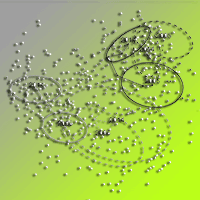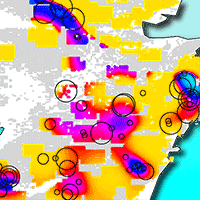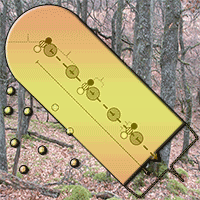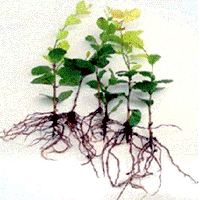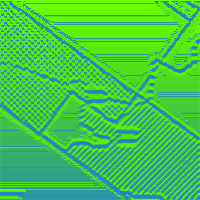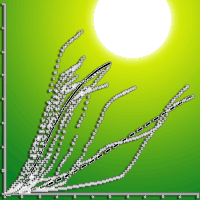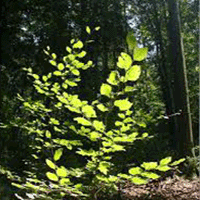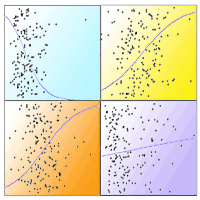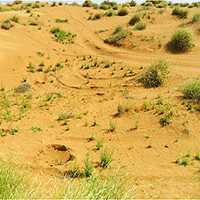Plant competition and deer browsing are two main factors which limit tree recruitment. We examined natural tree-recruitment processes under continuous-tree-cover management. Changes in plant communities and tree regeneration were monitored over an eight-year period at two different sites in a temperate hardwood forest in the North-East of France. We used paired control plot (unfenced areas, free access to deer) and exclosures (fenced areas, excluding deer) at both sites. Shade-tolerant browsing-tolerant opportunistic species (beech, Fagus sylvatica at site 1 and bramble, Rubus spp. at site 2) were present in low numbers at the beginning of the study. We found that these species used a sit-and-wait strategy, waiting for opportunities to proliferate (thinning and deer exclusion). In the exclosure at site 1, beech proliferate slowly. In the exclosure at site 2, bramble proliferated enough during the first two growing seasons to prevent tree recruitment. Thus, fencing encouraged beech sapling or bramble growth, and this growth in turn was detrimental to the richness and diversity of the plant community. The two study cases presented show that both plant competition and deer browsing can be problematic for tree recruitment. Our results further suggest that excluding deer is not sufficient to enhance the growth of browse-sensitive and moderately shade-tolerant tree species such as oaks (Quercus petraea and Q. robur).
Keywords
, , , , ,
Citation
Laurent L, Mårell A, Balandier P, Holveck H, Saïd S (2017). Understory vegetation dynamics and tree regeneration as affected by deer herbivory in temperate hardwood forests. iForest 10: 837-844. - doi: 10.3832/ifor2186-010
Academic Editor
Andrea Cutini
Paper history
Received: Aug 02, 2016
Accepted: Sep 05, 2017
First online: Oct 26, 2017
Publication Date: Oct 31, 2017
Publication Time: 1.70 months
© SISEF - The Italian Society of Silviculture and Forest Ecology 2017
Open Access
This article is distributed under the terms of the Creative Commons Attribution-Non Commercial 4.0 International (https://creativecommons.org/licenses/by-nc/4.0/), which permits unrestricted use, distribution, and reproduction in any medium, provided you give appropriate credit to the original author(s) and the source, provide a link to the Creative Commons license, and indicate if changes were made.

Breakdown by View Type
(Waiting for server response...)
Article Usage
Total Article Views: 49100
(from publication date up to now)
Breakdown by View Type
HTML Page Views: 39992
Abstract Page Views: 3527
PDF Downloads: 4351
Citation/Reference Downloads: 22
XML Downloads: 1208
Web Metrics
Days since publication: 2976
Overall contacts: 49100
Avg. contacts per week: 115.49
Article Citations
Article citations are based on data periodically collected from the Clarivate Web of Science web site
(last update: Mar 2025)
Total number of cites (since 2017): 16
Average cites per year: 1.78
Publication Metrics
by Dimensions ©
Articles citing this article
List of the papers citing this article based on CrossRef Cited-by.
(1)
Apollonio M, Andersen R, Putman R (2010)European ungulates and their management in the 21st century. Cambridge University Press, New York, USA, pp. 604.
Online |
Gscholar
(2)
Balandier P, Collet C, Miller JH, Reynolds E, Zedaker SM (2006)Designing forest vegetation management strategies based on the mechanisms and dynamics of crop tree competition by neighbouring vegetation. Forestry 79: 3-27.
CrossRef |
Gscholar
(3)
Balandier P, Marquier A, Casella E, Kiewitt A, Coll L, Wehrlen L, Harmer R (2013)Architecture, cover and light interception by bramble (
Rubus fruticosus): a common understorey weed in temperate forests. Forestry 86: 39-46.
CrossRef |
Gscholar
(4)
Bellingham PJ, Richardson SJ, Mason NWH, Veltman CJ, Allen RB, Allen WJ, Barker RJ, Forsyth DM, Nicol SJ, Ramsey DSL (2016)Introduced deer at low densities do not inhibit the regeneration of a dominant tree. Forest Ecology and Management 364: 70-76.
CrossRef |
Gscholar
(5)
Bergquist J, Löf M, Orlander G (2009)Effects of roe deer browsing and site preparation on performance of planted broadleaved and conifer seedlings when using temporary fences. Scandinavian Journal of Forest Research 24: 308-317.
CrossRef |
Gscholar
(6)
Bertin S, Palmroth S, Kim HS, Perks MP, Mencuccini M, Oren R (2011)Modelling understorey light for seedling regeneration in continuous cover forestry canopies. Forestry 84: 397-409.
CrossRef |
Gscholar
(7)
Boulanger V (2010)Pression d’herbivorie et dynamique des communautés végétales: influence à court et moyen termes des populations de cervidés sur la diversité des communautés végétales en forêt [Herbivory pressure and dynamics of plant communities: short- and medium-term influence of cervid populations on the diversity of plant communities in forests]. PhD thesis, Nancy - Henri Poincaré, France, pp. 289. [in French]
Gscholar
(8)
Braun-Blanquet J (1932)Plant sociology. The study of plant communities. McGraw-Hill Book Co. Inc., New York and London, pp. 476.
Gscholar
(9)
Davis MA, Wrage KJ, Reich PB, Tjoelker MG, Schaeffer T, Muermann C (1999)Survival, growth, and photosynthesis of tree seedlings competing with herbaceous vegetation along a water-light-nitrogen gradient. Plant Ecology 145: 341-350.
CrossRef |
Gscholar
(10)
Dodet M, Collet C, Frochot H, Wehrlen L (2011)Tree regeneration and plant species diversity responses to vegetation control following a major windthrow in mixed broadleaved stands. European Journal of Forest Research 130 (1): 41-53.
CrossRef |
Gscholar
(11)
Dumont B, Renaud PC, Morellet N, Mallet C, Anglard F, Verheyden-Tixier H (2005)Seasonal variations of red deer selectivity on a mixed forest edge. Animal Research 54: 369-381.
CrossRef |
Gscholar
(12)
Dunn OJ (1964)Multiple comparisons using rank sums. Technometrics 6: 241-252.
CrossRef |
Gscholar
(13)
Fischer HS (2015)On the combination of species cover values from different vegetation layers. Applied Vegetation Science 18: 169-170.
CrossRef |
Gscholar
(14)
Fotelli MN, Geler A, Peuke AD, Rennenberg H (2001)Drought affects the competitive interactions between
Fagus sylvatica seedlings and an early successional species,
Rubus fruticosus: responses of growth, water status and δ
13C composition. New Phytologist 151: 427-435.
CrossRef |
Gscholar
(15)
Fotelli MN, Rennenberg H, Geler A (2002)Effects of drought on the competitive interference of an early successional species (
Rubus fruticosus) on
Fagus sylvatica L. seedlings:
15N uptake and partitioning, responses of amino acids and other N compounds. Plant Biology 4: 311-320.
CrossRef |
Gscholar
(16)
Garel M, Bonenfant C, Hamann J-L, Klein F, Gaillard JM (2010)Are abundance indices derived from spotlight counts reliable to monitor red deer
Cervus elaphus populations? Wildlife Biology 16: 77-84.
CrossRef |
Gscholar
(17)
Gill RMA, Beardall V (2001)The impact of deer on woodlands: the effects of browsing and seed dispersal on vegetation structure and composition. Forestry 74: 209-218.
CrossRef |
Gscholar
(18)
Greenberg CH, Smith LM, Levey DJ (2001)Fruit fate, seed germination and growth of an invasive vine-an experimental test of “sit and wait” strategy. Biological Invasions 3: 363-372.
CrossRef |
Gscholar
(19)
Harmer R, Morgan G (2007)Development of
Quercus robur advance regeneration following canopy reduction in an oak woodland. Forestry 80: 137-149.
CrossRef |
Gscholar
(20)
Hegland SJ, Lilleeng MS, Moe SR (2013)Old-growth forest floor richness increases with red deer herbivory intensity. Forest Ecology and Management 310: 267-274.
CrossRef |
Gscholar
(21)
Hurlbert SH (1984)Pseudoreplication and the design of ecological field experiments. Ecological Monographs 54: 187-211.
CrossRef |
Gscholar
(22)
Julve P (1998)Baseflor. Index botanique, écologique et chorologique de la flore de France [Baseflor. Botanical, ecological and chorological index of the flora of France]. Web site. [in French]
Online |
Gscholar
(23)
Kirby KJ (2001)The impact of deer on the ground flora of British broadleaved woodland. Forestry 74: 219-229.
CrossRef |
Gscholar
(24)
Kuiters AT, Slim PA (2002)Regeneration of mixed deciduous forest in a Dutch forest-heathland, following a reduction of ungulate densities. Biological Conservation 105: 65-74.
CrossRef |
Gscholar
(25)
Leonardsson J, Lof M, Gotmark F (2015)Exclosures can favour natural regeneration of oak after conservation-oriented thinning in mixed forests in Sweden: a 10-year study. Forest Ecology and Management 354: 1-9.
CrossRef |
Gscholar
(26)
Mårell A, Ballon P, Hamard JP, Boulanger V (2012)Les dispositifs de type enclos-exclos: des outils au service de la gestion et de la recherche [Enclosure-exclosure: tools for management and research]. Revue Forestière Française 64: 139-150. [in French]
Online |
Gscholar
(27)
Marquis DA (1981)Effect of deer browsing on timber production in Allegheny hardwood forests of northwestern Pennsylvania. Research Paper NE-475, USDA Forest Service, Washington, USA, pp. 10.
Online |
Gscholar
(28)
Moser B, Schütz M, Hindenlang KE (2006)Importance of alternative food resources for browsing by roe deer on deciduous trees: the role of food availability and species quality. Forest Ecology and Management 226: 248-255.
CrossRef |
Gscholar
(29)
Oksanen J, Blanchet FG, Kindt R, Legendre P, Minchin PR, O’Hara RB, Simpson GL, Solymos P, Stevens MHH, Wagner H (2016)“vegan”: community Ecology Package. R package version 2: 3-3, web site.
Online |
Gscholar
(30)
Olesen CR, Madsen P (2008)The impact of roe deer (
Capreolus capreolus), seedbed, light and seed fall on natural beech (
Fagus sylvatica) regeneration. Forest Ecology and Management 255: 3962-3972.
CrossRef |
Gscholar
(31)
Pielou EC (1966)The measurement of diversity in different types of biological collections. Journal of Theoretical Biology 13: 131-144.
CrossRef |
Gscholar
(32)
Pommerening A, Murphy S (2004)A review of the history, definitions and methods of continuous cover forestry with special attention to afforestation and restocking. Forestry 77: 27-44.
CrossRef |
Gscholar
(33)
R Core Team (2014)R: A language and environment for statistical computing. R Foundation for Statistical Computing, Vienna, Austria.
Online |
Gscholar
(34)
Rooney TP (2001)Deer impacts on forest ecosystems: a North American perspective. Forestry 74: 201-208.
CrossRef |
Gscholar
(35)
Schütz J (1999)Close-to-nature silviculture: is this concept compatible with species diversity? Forestry 72: 359-366.
CrossRef |
Gscholar
(36)
Stroh N, Baltzinger C, Martin JL (2008)Deer prevent western redcedar (
Thuya plicata) regeneration in old-growth forests of Haida Gwaii: is there a potential for recovery? Forest Ecology and Management 255: 3973-3979.
CrossRef |
Gscholar
(37)
Vincent JP, Gaillard JM, Bideau E (1991)Kilometric index as biological indicator for monitoring forest roe deer populations. Acta Theriologica 36: 315-328.
CrossRef |
Gscholar
(38)
Wasem U, Häne K (2008)Souris, chevreuils et ronces influencent les chênes pédonculés régénérés naturellement [Mice, deer and brambles influence the naturally regenerated pedunculate oak]. Forêt Entreprise 61: 8-10. [in French]
Gscholar
